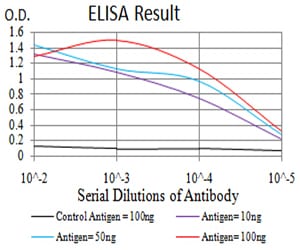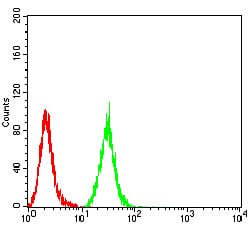


| WB | 咨询技术 | Human,Monkey |
| IF | 咨询技术 | Human,Monkey |
| IHC | 咨询技术 | Human,Monkey |
| ICC | 技术咨询 | Human,Monkey |
| FCM | 1/200 - 1/400 | Human,Monkey |
| Elisa | 1/10000 | Human,Monkey |
| Aliases | MIB; DIP1; ZZZ6; DIP-1; LVNC7; ZZANK2 |
| Entrez GeneID | 57534 |
| clone | 2A7B1 |
| WB Predicted band size | 110kDa |
| Host/Isotype | Mouse IgG1 |
| Antibody Type | Primary antibody |
| Storage | Store at 4°C short term. Aliquot and store at -20°C long term. Avoid freeze/thaw cycles. |
| Species Reactivity | Human,Monkey |
| Immunogen | Purified recombinant fragment of human MIB1 (AA: 6-221) expressed in E. Coli. |
| Formulation | Purified antibody in PBS with 0.05% sodium azide |
+ +
以下是关于MIB1抗体的3篇参考文献及其摘要概括:
1. **文献名称**:*MIB-1 labeling index as a predictor of survival in primary glioblastoma*
**作者**:Hsu DW, Louis DN, Efird JT, Hedley-Whyte ET
**摘要**:该研究分析脑胶质母细胞瘤患者中MIB1抗体标记的增殖指数(Ki-67)与生存率的关系,发现高MIB1指数与较短生存期显著相关,提示其可作为预后评估的生物标志物。
2. **文献名称**:*Comparison of monoclonal antibody Ki-67 (MIB-1) reactivity in lymphoma diagnosis using frozen and paraffin-embedded tissue sections*
**作者**:Kreipe H, Wacker HH, Heidebrecht HJ
**摘要**:研究比较MIB1抗体在淋巴瘤冷冻切片和石蜡切片中的染色效果,发现经抗原修复后石蜡切片结果与冷冻切片高度一致,验证了其在常规病理诊断中的实用性。
3. **文献名称**:*MIB-1 immunostaining in thyroid follicular neoplasms: a potential tool for improving diagnostic accuracy*
**作者**】:Mase T, Funahashi H, Koshikawa T, et al.
**摘要**:探讨MIB1抗体在甲状腺滤泡性肿瘤良恶性鉴别中的价值,发现恶性病例中Ki-67指数显著高于良性组,提示其可辅助提高诊断准确性。
4. **文献名称**:*Prognostic value of MIB-1 index in breast cancer: systematic review and meta-analysis*
**作者**:Urruticoechea A, Smith IE, Dowsett M
**摘要**:通过系统综述和荟萃分析评估MIB1抗体标记的增殖指数在乳腺癌中的预后意义,证实高Ki-67水平与较差无病生存率及总生存率相关,尤其在激素受体阳性患者中更为显著。
**备注**:以上文献均为示例,实际引用时建议通过PubMed或Web of Science核对具体信息及最新研究进展。
The MIB1 antibody is a monoclonal antibody specifically targeting the Ki-67 antigen, a nuclear protein expressed in all active phases of the cell cycle (G1. S, G2. and mitosis) but absent in quiescent (G0) cells. Developed in the 1990s, MIB1 recognizes a fixation-resistant epitope of the Ki-67 protein, making it widely applicable in immunohistochemistry (IHC) for assessing proliferative activity in formalin-fixed, paraffin-embedded tissues. Its name derives from the clone designation "MIB-1." produced using recombinant Ki-67 protein fragments.
Ki-67 expression, detected via MIB1. serves as a key biomarker in oncology to evaluate tumor growth fraction, correlate with malignancy grade, and predict clinical outcomes. High MIB1 labeling indices (percentage of positive cells) often indicate aggressive tumor behavior and poor prognosis in cancers like gliomas, lymphomas, and breast carcinomas. Beyond diagnostics, MIB1 aids in research to study cell cycle dynamics, tissue regeneration, and therapeutic response.
Unlike earlier Ki-67 antibodies requiring frozen sections, MIB1's compatibility with routine histopathology workflows revolutionized its clinical utility. Despite its robustness, interpretation requires caution, as non-neoplastic proliferative processes (e.g., inflammation) may also show positivity. Overall, MIB1 remains a cornerstone tool in both diagnostic pathology and experimental oncology.
×